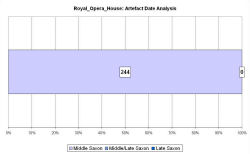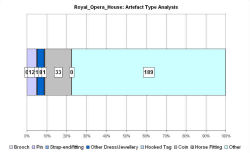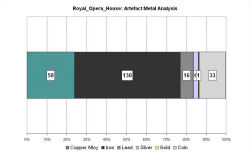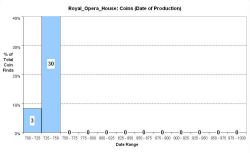Fingerprint charts for i) artefact date analysis, ii) artefact type analysis, iii) artefact metal analysis and iv) coins – date of production




Reference: Malcolm et al. 2003
Archives:
http://ads.ahds.ac.uk/catalogue/search/fr.cfm?rcn=EHNMR-1167212
doi:10.5284/1000329
Excavations undertaken in 1996 on the site of the former Royal Opera House in the City of Westminster covered an area of over 2500m², the largest single area ever to be excavated within the Middle Saxon trading port of Lundenwic.
Among the earliest archaeological features were the fragmentary remains of two Middle Saxon inhumation burials representing a dispersed cemetery, possibly serving a small settlement close to the waterfront along the Strand. In the late 7th and early 8th centuries the settlement underwent a period of expansion, which possibly began when the Mercians under Wulfhere took control, since the Saxon port of London is first mentioned in a charter of his sub-king Frithuwold in 672-4. As Lundenwic grew the cemetery was built over. A 3m-wide gravel road flanked by narrow drains was laid out and the first buildings were erected. As further buildings were added in the late 7th or early 8th century, the arrangement of building plots became more formalised and firmly established.
During the following decades the area seems to have become increasingly crowded as new buildings were constructed in previously unoccupied areas, sometimes over backfilled rubbish pits. The abundance of Ipswich Ware suggests that the main phase of occupation was during the reign of Offa of Mercia (757-96). The remains of 63 timber buildings were found, many with enclosed clay ovens or open hearths. Many hearths were probably used for cooking and heating, but deposits of slag indicate that some may have been used for smithing. Finds from household rubbish in pits and surface middens provided evidence for long-distance trade. Continental links are indicated by grey and black wares from northern France and Flanders and, to a lesser extent, by Badorf ware from the Rhineland, as well as by fragments of glass vessels and lava quernstones.
After AD 800 fewer buildings were erected and there was generally less activity. One of the latest features was a substantial defensive ditch. A hoard, comprising 23 Northumbrian stycas, was probably buried c. 850 in dark earth post-dating the abandonment of the site. The VASLE dataset is derived from the published excavation report.
Fingerprint charts for i) artefact date analysis, ii) artefact type analysis, iii) artefact metal analysis and iv) coins – date of production




© Internet Archaeology/Author(s)
URL: http://intarch.ac.uk/journal/issue25/2/4.4.48.html
Last updated: Tues Apr 21 2009